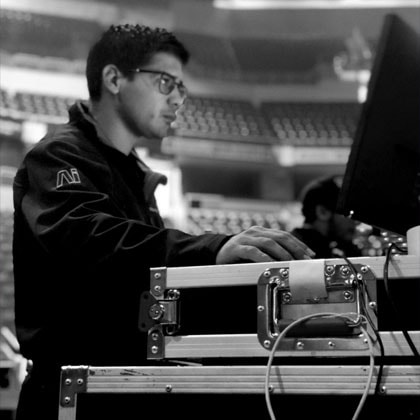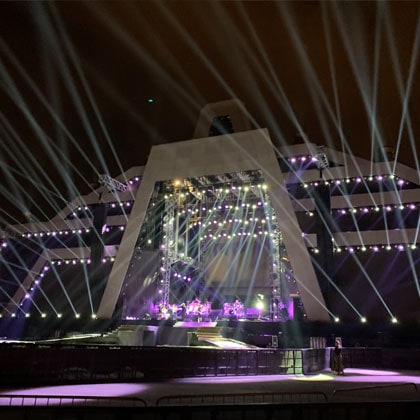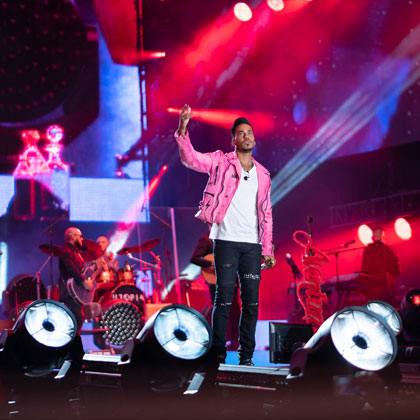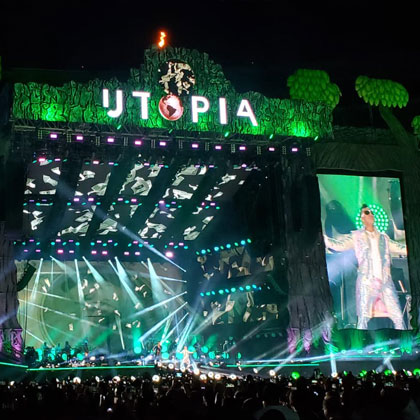
Lighting Designer Yamil Charif is the founder of Florida-based YC3 Lighting Design, a company whose stated aim is to be environmentally conscious in a traditionally wasteful industry. Part of a renowned Argentinian lighting family, he designs for a number of leading Latin American recording artists, including Romeo Santos, whose 2019 Utopia show at New York’s MetLife Stadium broke the venue’s all-time concert gross record for a single performance.
You come from a well-known lighting family – was there ever a chance that you might have pursued a different career path?
No, I’ve never worked or thought of doing anything else but Production Design. I’m thinking about the possibility of studying architecture, but Just as a hobby, and maybe to apply it to my current career.
In what ways do you, your father and brother collaborate, and influence each other’s work?
My father and brothers are 100 percent around in every project I’m working on. I consult them and ask them their opinion.
I have two brothers - Elian, 34 years old, and Khalil, 25 years old. Elian programs the lights for most of the shows that come out of our studio, even though he doesn’t live in the USA. Khalil is a Lighting Director for a few of our projects, and being the youngest, he is always up to date with the new technology.
My dad is our production guru. He showed us the way and we still consult a lot in every show. Even though my company doesn’t have any legal partnerships with anybody, I could say that they are equally part of it.
Did you have any formal education in lighting or event production?
My first time on a tour bus, I was 16 years old. Before I finished High School I was programming shows, so I’ve never stopped to go to school. But I could say that I did study a lot in this journey - I went to all the classes I could, and I still do, all the production software you can imagine, equipment, media servers, electronics, rigging, marketing - you name it! If I see a class that interests me, I’ll sign up. I even did an intense electrician class when I started, just to learn how to troubleshoot better. I’m a person that wants to know how everything works - and why.
Family aside, who have been your mentors and personal inspirations along the way?
That’s a great question. For sure I have learned from everyone I have crossed paths with. I love to ask questions and learn from everyone. I’m a big fan of collaborations and working with a big team.
I started from the bottom, setting up, running cables etc, and I worked for a lot of local companies in Miami and Buenos Aires. Everlast Productions in Fort Lauderdale gave me a big opportunity and I could say I learned a lot from their entire team. Working in Buenos Aires theaters for a year or two was a lot of fun. Gustavo Perez Lindo, and Enrique ‘Tito’ Romero, for example, were LDs that being my father’s age, and friends, always helped me and inspired me.
What are your career highlights? What has given you the biggest buzz and why?
I’m a humble guy, I’m not sure about that. I can say what gave me the biggest challenges and satisfactions, for example when we did the Miami Heat celebrations and the reveal of Lebron James, Chris Bosh and Dwayne Wade - that was epic. I was working for a company in Fort Lauderdale at the time and we all got together to come up with a design, program and setup in less than a week. It was really cool.
Another recent one was Romeo Santos at MetLife Stadium. Utopia was the name of the show – it was just massive and we took charge of all the production design and did everything in 45 days – content, scenic, lighting etc.
Residente last tour was another one, because I had the chance to program the lighting with my brother, and also because I had the chance to work with Wady Rodriguez, who is a great Lighting Designer.
And definitely, my first world tours with Ricardo Montaner... I was really young and had a lot of responsibility, but I was lucky to be surrounded by my brothers and father.
What causes you most frustration about the lighting business?
My biggest frustration is the amount of waste and consumption. Today artists want to have a massive lighting rig without a purpose.
What advice would you give to those who would like to follow in your footsteps?
I would say to never stop studying and pushing to reach their dream. Do everything carefully and ask colleagues for help.
How do you think of yourself, and how do you describe what you do - in terms of ‘art’ and ‘tech’?
I’m a fan of art and design all around - antique cars, shoes, architecture, painters.
I’m also very into technology. So, to answer the question, I’m minimalist in my designs just because of my awareness of the consumption in resources. Of course, if the show requires a lot of material I will use it, but I will still try to save some resources such as electricity, trucks etc.
I do love shows that have a lot of high-tech elements. I think that always gets people involved and makes the show unique.
Do you think you have a ‘style’ of lighting? If so, how would you describe it?
I’m not sure what my style would be. I’m very influenced by the “old school” designers, so it will definitely be front-, side- and back-light - something that the new generation is forgetting about - just to light!
Can you tell me a Yamil Charif lighting design rule of thumb?
Save resources without compromising the look of the show. For example, look at lumens and compare consumption with other fixtures.
Successful show production depends on collaboration, with great communication and understanding between artist/performer and creatives, and between the various creative disciplines. How do you ensure that runs as effectively as possible?
I have always believed that sharing all the information is best, so I try to stay in communication with the entire team all the time. I share my cloud folder and put everything there. And when I say everything, I mean it - from the CAD file to the show file, content, everything. That way, everyone is informed with the entire project from the beginning, and update it continuously at the same time. I try not to keep anything to myself and I always ask questions to everyone involved.
What traits do you admire most in those that you collaborate with?
I love seeing how other people do the same things I do, but in a different way. I learn so much from seeing that there is more than one way of doing it - and your way is not always the best.
Where do you find inspiration for your designs?
The artist or brand itself. We are the last link in an idea that an artist had: they record the music, put an album together, design the cover, all the marketing etc. So it’s very important to me to get the inspiration from their own work first, and then I focus on giving my touch and my humble opinion of what experience the audience of the show should have. I do use a lot of architecture and furniture design also as an inspiration.
Do you keep the impact of social media in mind when you design a new show?
Social Media is a window to today’s world - you look through there and you see it all. But it can harm you as much as it can help you. So I personally use it for recreation, and don’t focus too much on it professionally. You could find pictures of the same show from a flip phone and from a professional camera, so a picture from social media will never said the truth. I have always designed thinking about having things very well-lit, and focus on the look of the scene and the impact on the people on-site, so eventually it will look good on social media and have a ‘good’ impact - but it’s not my main focus when I design.
Are there areas of lighting design that you haven’t yet tried but would like to?
Architectural lighting. I would love to design the entire lighting for a museum or something similar.
Which other lighting designers do you particularly admire?
I have always looked up to and admired the top designers such as Leroy Bennett, Peter Morse, Butch Allen, Mark Fisher, Steve Cohen, Baz Halpin, Cory FitzGerald and a couple more. They are the best in this industry and they are definitely my inspiration and the reason why I keep working hard every day.
What do you think are the most important skills for a successful lighting designer?
That’s a hard question... I think having a critical eye, looking at all the details more than once.
What are the main performance characteristics you look for in a luminaire?
Output in comparison to consumption, color mixing, smooth movements. I like simple fixtures.
Can you tell us about your history with Vari-Lite, and your current favorite VL fixtures?
Vari-Lite has been my favorite brand since the beginning. If you love lighting, you know who changed the industry and what brands made a difference. Today, the VL10 is my favorite fixture. Also I still design with VL3500 Wash because of its output and performance. And the new VL5 LED: I can’t wait to have a rig full of them, but I haven’t had the chance to use them on-site yet.
Your company is founded on environmental principles – how does that influence the way you work and the tools you use?
It’s already implemented so we don’t even think about it much, I just look at the technical data from a fixture and then test it and know if it will work for what I’m looking for. It’s like being vegetarian - at the beginning it’s a little bit challenging, but after a while it becomes second nature - just look at the ingredients.
We also limit consumption in a lot of other ways - for example, using digital files, not printing unnecessary plots, etc.
What measures would you encourage other design & production companies to implement in order to reduce their environmental impact?
Reduce unnecessary flying, for example doing meeting with Zoom. Look at the output and features of the fixture before choosing it - I think that would be the principal point. With today’s technology, it’s super simple.
Low power consumption is obviously important to your business. What do you think about the current state of LED stage lighting fixtures on the market?
I think it’s amazing how far the technology has gotten, but it’s also important to inform yourself about the quality of the light. I remember I did a class about LED technology with Philips Lighting about six years ago, where they taught us about the differences in quality, wattage and a lot of other awesome information. LED fixtures today are impressive, but I also believe that sometimes it’s still necessary to use conventional lights - HMI or other types of lamps.
How closely do you work with manufacturers in pushing them to develop the tools that you want/need?
I’m in constant contact with manufacturers, but usually I just give them my opinion and feedback on their products.
What’s missing from the LD’s toolkit? What would you like to see from manufacturers?
The industry is growing so fast that it’s hard to say what’s missing because ‘we’ as lighting designers are always trying to catch up! What I would like to see from all manufacturers is a standard in channel names and functions, like it used to be - that way cloning in consoles is easier and better. Today, each fixture has too many modes and channel names that only exists in those particular fixtures. Those channels are great sometimes, but I think all the fixtures should have a “standard” mode that matches all the rest. For example, some lights reset on the shutter channel, some lights don’t shutter if other channels are active. And if you get into the Media Server world, it’s another big fight...




